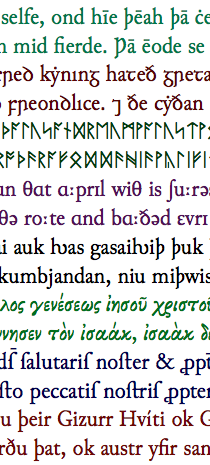Junicode

A new version of Junicode is under development at https://github.com/psb1558/Junicode-New, and development of the version hosted here is suspended. Minor enhancements and fixes for the legacy version of Junicode may be added from time to time, but these will be released in the “legacy” folder of the new Junicode site, https://github.com/psb1558/Junicode-New/tree/master/legacy.
Junicode (short for Junius-Unicode) is a TrueType/OpenType font for medievalists with extensive coverage of the Latin Unicode ranges, plus Runic and Gothic. The font comes in four faces. Of these, regular and italic are fullest, featuring complete implementation of the Medieval Unicode Font Initiative recommendation, version 4.0. The bold and bold italic faces are less full.
For lovers of old-style type, the Junicode package also includes Foulis Greek, an eighteenth-century Greek typeface with numerous variants and old-style ligatures.
Junicode is and always will be free (available under the Open Font License). This means that you can use it without charge in any publication, print or electronic, and you may adapt the font for your own use and even distribute your adaptation, as long as you obey the terms of the license.
Junicode currently contains 3002 characters in the regular style. These Unicode ranges are either complete in the regular style or they contain substantial numbers of glyphs (especially those of interest to medievalists):
- Basic Latin
- Latin 1 Supplement
- Latin Extended A
- Latin Extended B
- Latin Extended D
- Latin Extended Additional
- IPA Extensions
- Phonetic Extensions
- Spacing Modifier Letters
- Combining Diacritical Marks
- Combining Diacritical Marks Supplement
- Runic
- Number Forms
- Enclosed Alphanumerics
- General Punctuation
- Superscripts and Subscripts
- Gothic
A number of other ranges contain at least a few glyphs. Instructions (“hints”) for improved screen display have been added using the terrific ttfautohint program by Werner Lemberg.
To download, go to the Junicode Download Page and click the “latest version” link. If you want the WOFF version (for embedding in web pages), navigate into the “junicode” folder, and then the folder for the current version (at the top of the list). For source code, click the "Git respository" link on the left, then choose the "Master" branch. Source code consists mostly of UFO (Unified Font Object) files. To generate the Junicode font using the Makefile in the repository requires Fontforge (with Python bindings), the Adobe Font Development Kit, and ttfautohint. However, the fonts can probably be generated by several font editing programs.
To submit bug reports or feature requests, please visit the project page.